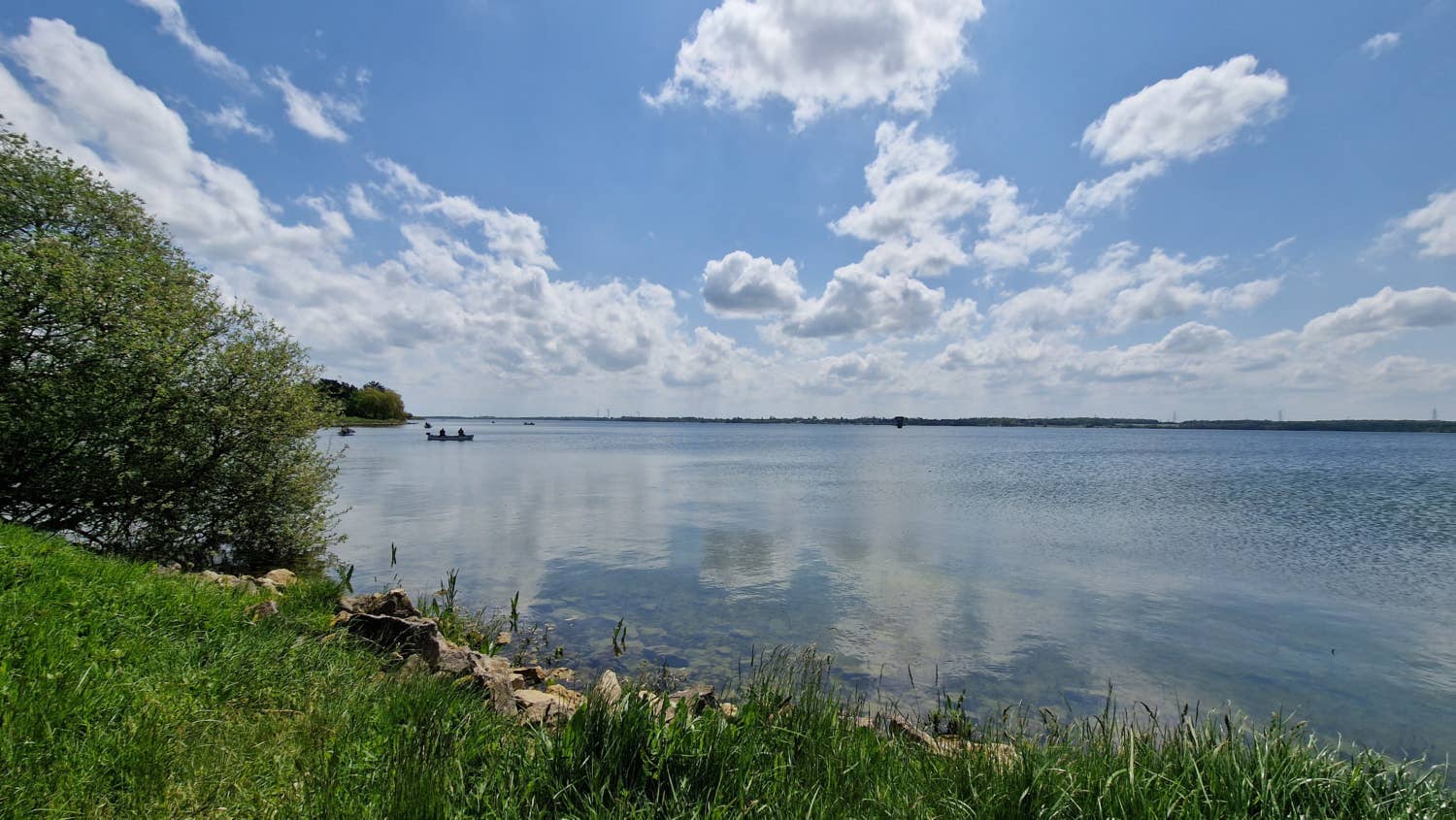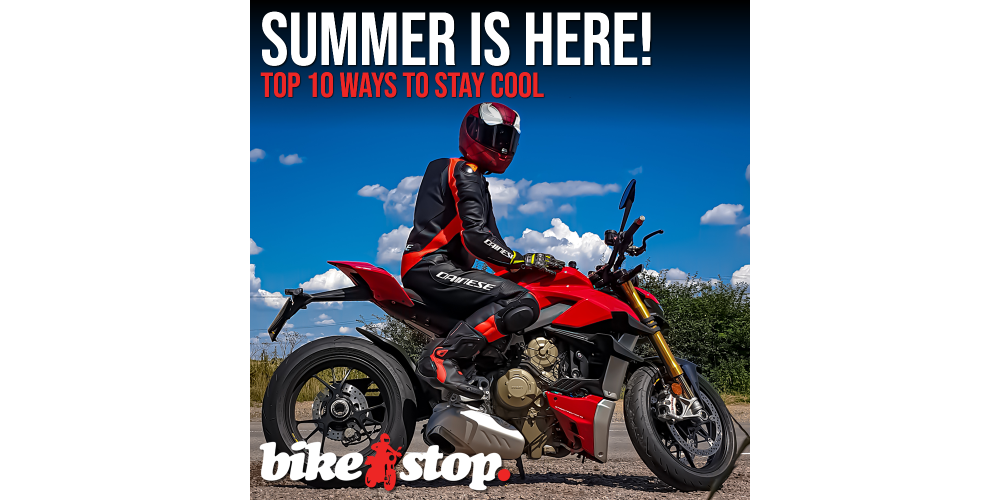If a genie were to grant me three wishes, I suspect the first two would revolve around an endless supply of cash and the ability to consume cake without gaining weight. I'd spend so much money on cake. However, the final wish would be for every day to be perfect for motorcycling. How nice it would be to have the Goldilocks conditions where it's neither too hot nor too cold. If it could be dry, cloudless and around 23°c, I'd be a happy boy. A happy boy full of cake.
Sadly, living in the UK means we have to endure months of it being too cold, followed by a couple of months of too wet and then a handful of months when it's too hot and humid to think straight. Admittedly, there are a couple of weeks where perfect conditions punctuate the otherwise awful climate, but on the whole, it's easy to find an excuse not to ride. It's not all that long since I wrote about my newly acquired Keis heated jacket and gloves combo, but now, as I write this, the mercury is creeping inexorably towards 30°c, and motorcycling seems less fun.
Of course, it's entirely possible I'm a coward who's happier with complaining than riding, but I'm sure I'm not alone in my dislike for stickier weather. Nevertheless, I will no doubt be out and about on the bike a lot over the next few months, and experience has taught me a few ways to deal with the searing heat. So, here are my top ten tips on coping with the unpleasantness of a beautiful summer.
1. Don't ride
It may seem a bit obvious and maybe a bit churlish to start off by saying this, but it is an option not to go riding in the baking sun. This is probably more relevant on longer bike tours where you may have a week or two of riding but also applies over the course of a long weekend. Riding in hot weather can really take it out of you. Motorcycling burns more calories than you probably imagine, with a 70kg male able to burn up to 200kcal in sixty minutes of moderately intense riding. Take your bike on the track, and you can double that figure. Don't underestimate the physicality of riding.
So, given how exhausting riding can be, it's not a bad thing to choose a day out of the saddle. If you're on a longer tour, reserve a day to chill out and reset. Walk into the local town or city and have a day exploring, drinking and relaxing, or have a day by the pool. Nobody's going to think you're less of a human for taking some time out, and you'll be revitalised and ready to go on your next day of riding. Even if you're not touring, a whole day of riding during a summer's day in the UK can be equally exhausting. Save Saturday for riding and Sunday for recovery. You'll feel all the better for it.


2. Hydration
This should go without saying but staying hydrated is arguably the most critical item on this list. Dehydration is the evil twin of heat exhaustion; the two go hand in hand. Like it or not, if you're out riding all day in 30°c heat, you'll sweat. Every drop of sweat that oozes out of your body drains you of water and electrolytes, which must be replenished. Make sure you take regular stops to top up on water and occasionally guzzle a sports drink to replenish your electrolytes. If you're riding far away from civilisation, make sure you take a few bottles of water in your pack or use a camelpack to take fluids while you're on the go.
You should definitely avoid alcohol and caffeine, too. Alcohol will impair your judgement and ability to ride but also accelerates dehydration, which you absolutely want to avoid. If you're desperate for a summer beer, have it after your ride—it'll seem more satisfying, too! The case for avoiding caffeine isn't as solid as for alcohol, but if there's a choice of water or coffee, go for the water.
3. Base Layers
We've already established that riding in heat will make you sweat, and while that sounds deeply unpleasant, it performs the vital function of keeping you cool. Our bodies use sweat to regulate temperature by cooling the skin's surface through evaporation. To increase the efficiency of evaporative cooling, wearing synthetic base layers helps wick away moisture from the skin and increases the cooling effect. Depending on the base layers you buy, they will also likely feature light compression which aids circulation and suppresses fatigue.
Also, slippery skin-hugging base layers make it significantly easier to put on and remove leathers. If you've ever tried to take off sweaty leathers, I'm sure you'll be familiar with the routine of getting slightly stuck and then dancing around the room like a demented crab in a bid to take them off.
4. All the gear, all the time
I realise that during summer there's always the temptation to ride without proper gear. Few people want to be wearing half a dead cow or kangaroo when the pavements start melting, but if you've considered the first three items on this list, you should be in a good position to deal with this item. Protective clothing has come on in leaps and bounds over the last couple of decades, so there's really no reason to avoid gearing up properly for summer riding. With a combination of a mesh jacket and trousers, along with vented and perforated boots and gloves, there's no reason why you can't stay relatively cool whilst out on the bike. I use a Dainese mesh jacket in summer and when combined with good base layers, it keep me perfectly cool whilst also providing adequate protection should something go awry.
The other benefit of full coverage is that you're protected from the red-eyed monster of hideous sunburn. So long as you remember to use sun tan lotion on your neck, you should be able to get through summer without a single inch of burnt flesh.


5. Avoid afternoons
Another obvious point, but one I feel is worth making. The hottest time of the day tends to be between lunch and dinner (or dinner and tea, if you're a Northerner). This is when the sun is at its most brutal and keen to dry you out like a sultana. If you're planning to ride, the best time is to get out in the mornings and evenings when it's a bit cooler. However, if you are going to go out in the evening, remember that's the time that local wildlife also feels it's more comfortable to start exploring. Depending on where you're riding, be vigilant for Bambi, who may be edging out onto the roads to enjoy the slightly cooler conditions.
Remember that at the moment, you'll have sunlight up until half past nine in the evening, so post-work evening rides are more than viable and slightly more pleasant.
6. Use technology
There are a few products out there which can boost your evaporative cooling. While in winter we favour heated vests, in summer we can make use of cooling vests. They're not particularly high-tech, but they are clever. You simply submerse the vest in water, allowing its special fabric to absorb as much H2O as possible without weighing the same as a fat elephant, and then wear it under your normal riding gear and over your base layers. As you ride, the water seeps out and effectively air-conditions your body.
Other cooling vests feature a bladder which you fill with water, but dissipate that fluid in the same way. In addition to the vest, you can find neck wraps which operate in the same way and cool down the only part of your body exposed to daylight.
7. Don't use technology
If you don't want to splash out on fancy cooling vests and neck wraps, there's a cheap and fun alternative. Pour water down the front and back of your jacket and trousers. The upside is you get free air-conditioning, however the downside is that it doesn't last for too long and you'll need to stop every now and again to resoak your gear. It's probably best to avoid filling your helmet with water, but you should be able to soak a bandana or balaclava and wear it under your lid.
If you're really well-prepared, you can fill your jacket and trousers pockets with ice cubes. As silly as it may seem, it will last a bit longer than the water trick, although might give you a bit of a jump when you first place ice cubes in your pockets.
8. Take regular breaks
If it's a really nice day and you're in the full throes of riding heaven, it may be tempting to keep riding until you need to stop for fuel. While this isn't so much a problem on a Ducati Streetfighter V4, which will gobble a tank in 80 miles, it's more of an issue on large adventure bikes with 350-mile ranges. There are several good reasons to take a break. Firstly, it allows you a moment to top-up on fluids (see point 2), but is also gives you a moment to recalibrate. You may not realise how exhausted you are until you get off the bike and stretch your legs. Make sure you take off your helmet and gloves, and remove your jacket. If you're wearing one-piece leathers, unzip them and let some air in. Probably best to keep your trousers on, however.
There are typically hundreds of decent places to stop if you're road riding, but if you're off the beaten track, try to find some shade to perch in whilst quaffing some water and letting your blood circulate. Don't be a hero and try to ride through it. This isn't the TT.


9. Slow your pace
The harder you ride, particularly on track days or your favourite B-roads, the more physical effort is required. The more physical become, the hotter you'll get and the more exhausted you'll become. Some people will argue that riding faster increases airflow and cools you down more, but the extra physical effort required makes it a bit of a sunken cost. It's like speeding up when you're running out of fuel so you can get to the petrol station more quickly.
There's no shame in having a pleasant, enjoyable ride and taking in the scenery without smashing the bike off the limiter in each gear and getting your knee down on every corner.
10. Don't be an ass
If you experience symptoms like lightheadedness, dizziness, headache, cramps, or unexpected cool and clammy skin, it could be a sign that your body is overheating. Heat exhaustion can lead to heat stroke, which can be extremely dangerous and even fatal. It's important not to tough it out and ignore the symptoms. Instead, find the nearest place to stop and immediately take steps to cool down. You can remove your helmet and place a cold, wet towel around your head, seek refuge in an air-conditioned shop or restaurant and drink plenty of water. Take some time to recover from the heat.
If you don't feel any better after taking a break and taking on fluids, seek medical attention. There are no prizes for being a hero.








